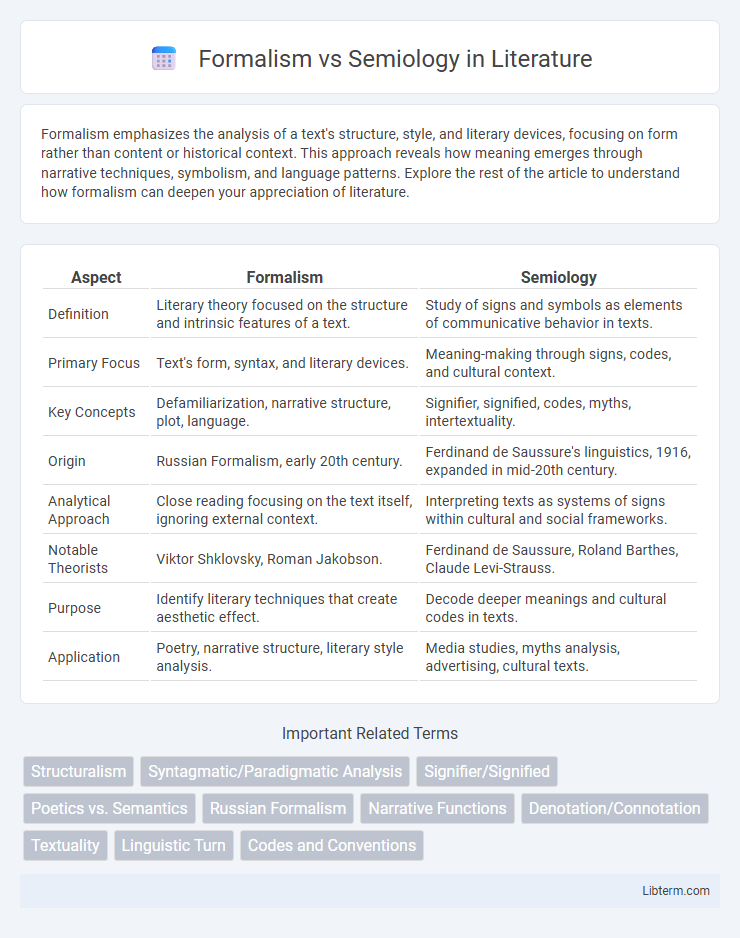Formalism emphasizes the analysis of a text's structure, style, and literary devices, focusing on form rather than content or historical context. This approach reveals how meaning emerges through narrative techniques, symbolism, and language patterns. Explore the rest of the article to understand how formalism can deepen your appreciation of literature.
Table of Comparison
| Aspect | Formalism | Semiology |
|---|---|---|
| Definition | Literary theory focused on the structure and intrinsic features of a text. | Study of signs and symbols as elements of communicative behavior in texts. |
| Primary Focus | Text's form, syntax, and literary devices. | Meaning-making through signs, codes, and cultural context. |
| Key Concepts | Defamiliarization, narrative structure, plot, language. | Signifier, signified, codes, myths, intertextuality. |
| Origin | Russian Formalism, early 20th century. | Ferdinand de Saussure's linguistics, 1916, expanded in mid-20th century. |
| Analytical Approach | Close reading focusing on the text itself, ignoring external context. | Interpreting texts as systems of signs within cultural and social frameworks. |
| Notable Theorists | Viktor Shklovsky, Roman Jakobson. | Ferdinand de Saussure, Roland Barthes, Claude Levi-Strauss. |
| Purpose | Identify literary techniques that create aesthetic effect. | Decode deeper meanings and cultural codes in texts. |
| Application | Poetry, narrative structure, literary style analysis. | Media studies, myths analysis, advertising, cultural texts. |
Introduction to Formalism and Semiology
Formalism, rooted in Russian literary theory, emphasizes the structural elements of texts such as language, syntax, and narrative techniques to understand meaning independently of cultural or historical contexts. Semiology, founded by Ferdinand de Saussure, studies signs and symbols as part of a system of communication, highlighting the relationship between the signifier (form) and the signified (concept). While Formalism isolates the mechanics of literary art, Semiology situates these elements within broader semiotic systems to decode meaning.
Historical Context and Development
Formalism emerged in early 20th-century Russia with figures like Viktor Shklovsky emphasizing the autonomy of literary form and technique, detaching meaning from authorial intent and cultural context. Semiology, rooted in the work of Ferdinand de Saussure in the early 20th century and further developed by Roland Barthes, evolved as a broader study of signs and symbols within language and culture, highlighting the relational nature of meaning across various media. The historical development of Formalism and Semiology reflects a shift from analyzing intrinsic textual structures toward exploring cultural codes and communicative systems, shaping modern literary and cultural theory.
Key Principles of Formalism
Formalism emphasizes the autonomy of the text, analyzing its structure, language, and literary devices without considering external contexts such as author intent or historical background. Key principles include the examination of narrative techniques, syntax, and phonetic patterns to uncover how meaning is constructed within the text itself. This approach prioritizes close reading and the intrinsic features of literature to highlight its artistic form and function.
Foundations of Semiology
Foundations of Semiology stem from Ferdinand de Saussure's theory of signs, emphasizing the relationship between the signifier (sound/image) and the signified (concept), contrasting with Formalism's focus on inherent structures and formal elements in literature. Semiology analyzes cultural and social contexts shaping meanings, prioritizing how signs function within communication systems. This approach extends beyond the text to interpret underlying codes and conventions influencing meaning-making processes.
Major Theorists and Influences
Formalism, championed by Viktor Shklovsky and Roman Jakobson, emphasizes literary form, structure, and the defamiliarization of language as key to understanding texts. Semiology, rooted in Ferdinand de Saussure's linguistic theories and advanced by Roland Barthes, interprets cultural phenomena as systems of signs and explores the relationship between signifiers and signified. Both approaches significantly influence contemporary literary criticism, with Formalism providing tools for dissecting narrative techniques and Semiology offering frameworks for decoding cultural meanings.
Methodologies Compared
Formalism emphasizes close reading and structural analysis of literary texts, prioritizing elements like syntax, rhyme, and narrative techniques to uncover meaning within the text itself. Semiology, rooted in the study of signs and symbols, examines how meaning is constructed through cultural codes and sign systems, integrating linguistic and social contexts into interpretation. Formalism's methodology isolates the text from external influences, whereas Semiology adopts a broader interdisciplinary approach, linking textual elements to societal and cultural frameworks.
Applications in Literary Criticism
Formalism in literary criticism emphasizes analyzing a text's structure, language, and literary devices to uncover meaning intrinsic to the work itself. Semiology applies the study of signs and symbols, interpreting literary texts as systems of signs that generate meaning through cultural and social codes. Both approaches offer critical tools for dissecting narrative techniques, with Formalism focusing on form and language, while Semiology explores broader signification processes within literature.
Impact on Art and Media Analysis
Formalism emphasizes the intrinsic features of art such as composition, color, and form, influencing media analysis by prioritizing visual and structural elements over contextual content. Semiology extends this analysis by interpreting signs and symbols within artworks and media, uncovering deeper cultural and societal meanings embedded in texts and images. Together, these approaches reshape art and media criticism by balancing technical aesthetics with interpretive decoding, enriching audience understanding and critical discourse.
Criticisms and Limitations
Formalism is criticized for its narrow focus on textual elements, often ignoring cultural, historical, and social contexts that influence meaning. Semiology faces limitations in its reliance on arbitrary sign systems, making interpretations subjective and sometimes inconsistent across cultures. Both approaches struggle to fully capture the dynamic and fluid nature of meaning in communication and texts.
Conclusion: Ongoing Debates and Future Directions
The debate between Formalism and Semiology continues to shape literary and cultural theory, with Formalism emphasizing structural elements and Semiology focusing on signs and symbols within texts. Future directions involve integrating digital humanities and cognitive sciences to deepen understanding of narrative mechanisms and semiotic processes. Emerging interdisciplinary approaches promise to reconcile methodological differences, fostering richer interpretations and innovative theoretical frameworks.
Formalism Infographic

 libterm.com
libterm.com